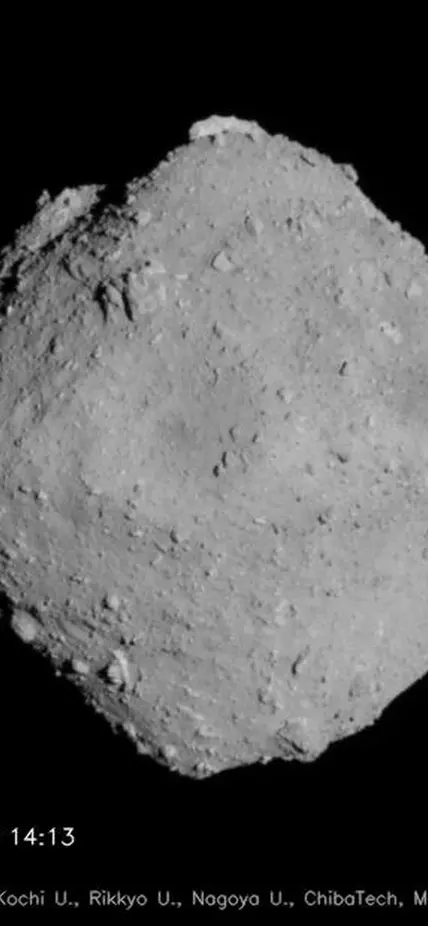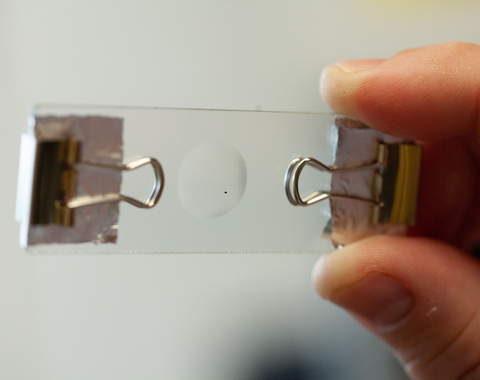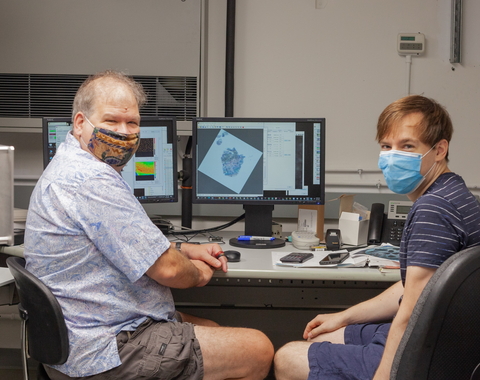“Dirt” from the near-Earth asteroid Ryugu arrived on Earth in the wee hours of the morning on December 6, 2020, courtesy of the Japanese Space Agency (JAXA) mission Hayabusa2. The capsule of Ryugu rocks is both the second and largest sample ever successfully recovered from an asteroid, and scientists at the Carnegie Science Earth and Planets Laboratory (EPL) can’t wait to pounce on it!
Carnegie staff cosmochemist Larry Nittler was one of only nine U.S. scientists selected by NASA to be a “participating scientist” on the mission. Nittler has been involved in the project since 2015 and has had a hand interpreting some initial data from Hayabusa2 throughout its six-year-long mission.
Said Nittler, “They picked nine scientists, and I was one of them. My proposal included help with the asteroid operations, participation in interpreting the remote sensing data, and picking where we landed to get a sample from the asteroid. But the biggest part of my proposal is to analyze the samples.”
A larger group of Carnegie scientists, including EPL Director and geochemist Richard Carlson, geochemist George Cody (who is the deputy lead on the Insoluble Organics sub-group lead by former Carnegie Fellow Prof. Hikaru Yabuta, now a Professor at Hiroshima University), and cosmochemist Conel Alexander (who is a member of the Isotope sub-group), will join Nittler to study the sample when it ultimately arrives on our campus, hopefully near the end of 2021.
So what can this space dirt tell us that is worth expensive missions to space, extreme social distancing protocols, and the commitment of some of our planet’s brightest scientific minds? As it turns out, framed through the questions below, it could help tell the story of our Galaxy—revealing insights into the creation of our planet and even the existence of life itself.
What makes asteroids so special?

To scientists like Larry Nittler, meteorites and asteroids hold the clues to what happened in the first few millions of years of our Solar System.
The Solar System started out as a disk of gas and dust swirling around our fresh, new Sun. Nittler explains, “As the gas began to cool, atoms started sticking together to form dust grains, and then the dust grains start sticking together to form bigger dust grains, and so on and so forth until these rocks grow into meters, then kilometers, and eventually you have asteroid-size things, which collide into each other and form planetesimals and then planets.”
The asteroid Ryugu photographed by Hayabusa2 at a distance of about 20 km. The image was taken at around 23:13 JST on June 30, 2018. Image credit: JAXA, University of Tokyo, Kochi University, Rikkyo University, Nagoya University, Chiba Institute of Technology, Meiji University, University of Aizu and AIST.
It was the violent process of colliding and reshaping that ultimately left what we see today. During this process, planets—and even some large asteroids—get so hot from either the collisions or from radioactive decay that they completely melt. This melt mixes all of the component parts together and essentially erases the information that scientists would otherwise use to create a timeline of how the Solar System formed. Asteroids like Ryugu, on the other hand, didn’t get big enough to melt.
According to Nittler, “The asteroids that never got big enough to melt or even get heated enough to change chemically still contain a record of what the stuff was like in the disc.”
Does this asteroid look familiar to you?
Almost all meteorites are chunks of asteroids (which are themselves chunks of planetesimals) that broke up and, one way or another, ended up on Earth. Nittler’s studies focus on a particular type of meteorite: carbonaceous chondrites. These meteorites are compelling to scientists because they contain key ingredients necessary for life, like carbon and water. Plus, they are considered some of the most primitive samples of space rock available, serving as fossils of the very earliest stages of the Solar System.
Scientists believe that carbonaceous chondrites come from carbonaceous asteroids—also called C-type asteroids—and that these asteroids could be what seeded Earth with carbon and water. Ryugu was chosen as the Hayabusa2 mission target because of its proximity to Earth and because it is one of these potentially life-giving C-type asteroids. However, we don’t and won’t know any of this for sure until the scientific team compares the composition of known chondrites to the composition of Ryugu.
The first Hayabusa mission recovered samples from Itokawa, a S-type or “stony” asteroid. The Ryugu sample is the first-ever C-type asteroid that scientists will be able to study firsthand.
Hayabusa2's second chamber (at left) contains a sample of Ryugu collected from beneath the asteroid's surface which at first glance looks similar to a chondrite sample found in Antarctica 20 years ago (at right). In both the meteorite and the Ryugu samples you can see bright specks. In the meteorite, these are "Calcium Aluminum-rich Inclusions" which are ceramic-like grains that are the oldest known objects that we know formed in the Solar System. Scientists at Carnegie will compare the Ryugu samples to known meteorites. Credit: Larry Nittler
Nittler explained, “People have long thought there's a connection between these kinds of asteroids and these kinds of meteorites. That is why both JAXA and NASA chose to send sample return missions to these carbonaceous asteroids. We're really, really hoping to see if they’re related and if they look like material we have in carbonaceous chondrites.”
He continued, “We expect them to look the same, but we could be completely wrong.”
What can stardust tell us about Ryugu’s past?
A key thing that the scientific team, including Nittler, will be looking for in the Ryugu samples is the presence of “presolar grains.” Says Nittler, “Presolar grains are something I do a lot of work on in meteorites, and they are one of the primary reasons that scientists are interested in Ryugu.”
Presolar grains are extremely small grains of dust that were formed in other stars and pre-date our own Sun and Solar System. Often found protected in chondritic meteorites, they represent the absolute original building blocks of the Solar System. If you see a presolar grain you’re looking at something older than our Sun, which means they can be used to measure the full history of our Solar System.

Chemical map of the pristine carbonaceous chondrite Acfer094. In between the chondrite's constituents pieces (colored) is a primitive matrix in which presolar grains can be found. Image courtesy Maximilien Verdier-Paoletti.
“One really important question for studying Ryugu is, ‘Does it have presolar grains and, if so, what kinds and how many?’” said Nittler, “That information can tell us something about the early history of the asteroid processing because we have some understanding from studying lots of meteorites, how asteroid processing affects these grains.”
Chemical reactions—like the creation of clay minerals due to the presence of water—can interact with and erase presolar grains. Therefore, more presolar grains in a meteorite or asteroid means that it probably is a relatively untouched and unprocessed sample from the Solar System’s infancy. Scientists like Nittler should be able to use what they’ve already learned about how presolar grains age in meteorites to nail down what Ryugu’s starting materials looked like—and to build a history of the asteroid and of the Solar System itself.
So what can we expect from Ryugu? Said Nittler, “Based on Hayabusa2’s remote sensing data, the most likely scenario is that Ryugu has been heated and aqueously altered enough that there won't be very many presolar grains, but we need to look for them to find out.”
Did the building blocks of life form in asteroids?
In addition to helping scientists build a picture of how planets formed in our early Solar System, Ryugu may contain clues to the origins of life on Earth.
Figuring out how hydrogen, carbon, and nitrogen ended up on Earth is an essential part of understanding the origins of water and life on our planet. Scientists like Carnegie’s George Cody and Conel Alexander study organic and hydrogen-containing molecules in chondrites, and both look forward to studying the Ryugu sample.
Said Alexander, “My hope is that the Ryugu material is not like the meteorites we have in our collections and it provides new insights into processes that were operating in the early Solar System, particularly the origins of organic material and water.”

A ~10 µm large fragment of insoluble organic matter from the meteorite Tagish Lake. Image by former postdoc My Riebe.
Nittler added, “Conel and George will look for what's called the insoluble organic matter, which is the main carrier of organic carbon in carbonaceous chondrites. It’s basically a carbon-dense coal-like substance, a kind of macromolecular gunk. We've been working for years on our campus, trying to understand how and where it formed and how it may have played a role on the early Earth. Conel and George are two of the world's experts in this.”
Nittler continued, “Once the sample is on campus, we'll analyze the carbon, if it's there, in these samples. Using highly specialized equipment, we’ll be able to characterize it and compare it to what we already know about this material in chondrites.” He concluded, “This work will help us better understand the distribution of carbon in the early solar system and, ultimately, how it ended up on Earth.”
When will the samples arrive at the Earth and Planets Laboratory?
The Hayabusa2 mission will help us answer many questions and likely raise even more questions for us to answer in the future. But for now, we must wait!
The sample still has a long journey before it ends up in our labs. It was opened and assessed in December 2020, but for the first six months, the sample will be in the curation stage under vacuum conditions. Then the JAXA scientists will take selected samples out of the vacuum and give them to different teams to get started on some of these questions. Then, about a year into the process, JAXA will send tiny samples to scientists worldwide to analyze in their own labs.
Near the end of 2021 we should see the samples in our labs—and our fun will begin!


